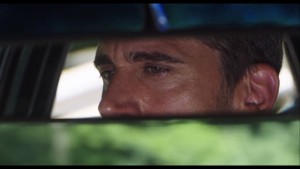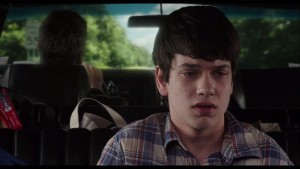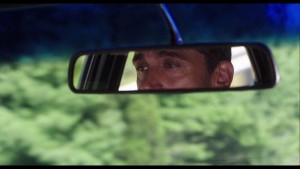Mar
2015
Found Scene
Film: The Way Way Back (2013)
Quick Film Summary: Shy 14 year-old Duncan goes on a summer holiday with his mum, his mum’s boyfriend Trent and Trent’s daughter Steph. The friends he makes at his new job at the water park helps him gain his self-confidence.
Chosen Scene: Opening scene.
Shot List:
- Extreme C/U of Trent’s (Duncan’s future step-Dad) eyes in rear-view mirror.
- Medium C/U of Duncan sitting in the very back of the car, his back facing Trent.
- Extreme C/U of Trent’s eyes in rear-view mirror.
- Medium C/U of Duncan sitting in the very back of the car, his back facing Trent.
- Extreme C/U of Trent’s eyes in rear-view mirror.
- Medium C/U of Duncan sitting in the very back of the car, his back facing Trent.
- Extreme C/U of Trent’s eyes in rear-view mirror.
- Medium C/U of Duncan sitting in the very back of the car, his back facing Trent.
- Medium C/U of Duncan turning around to face Trent.
- Medium C/U (from Duncan’s P.O.V) of the back of Pam (Duncan’s mum) asleep in the passenger seat.
- Medium C/U of Steph (Duncan’s future step-sister) asleep.
- Medium C/U of Duncan facing Trent.
- Extreme C/U of Trent’s eyes in rear-view mirror.
- Closer Medium C/U of Duncan facing Trent.
- Extreme C/U of Trent’s eyes in rear-view mirror.
- Closer Medium C/U of Duncan facing Trent.
- Extreme C/U of Trent’s eyes in rear-view mirror.
- Closer Medium C/U of Duncan facing Trent.
- C/U of Trent’s eyes in rear-view mirror.
- Closer Medium C/U of Duncan facing Trent.
- Further Medium C/U of the back of Duncan, now facing Trent.
- C/U of Trent’s eyes in rear-view mirror.
- Closer Medium C/U of Duncan facing Trent.
- Medium C/U of Duncan sitting in the very back of the car, his back facing Trent.
No. of Camera Set-ups: 8
Analysis:
The film The Way Way Back opens with an awkward conversation between Duncan and his mum’s boyfriend Trent in the car on the way to their summer holiday house. The camera coverage chosen to film this scene establishes the distant and troubled relationship between Duncan and Trent as well as highlighting Duncan’s personality and view of the world.
The scene opens with an extreme close-up (no. 1) of Trent’s eyes in the rear-view mirror as he tries to engage in a conversation with Duncan. Choosing to frame his eyes so closely and never actually showing his whole face establishes him as an imposing and authoritative figure. As he continues to belittle Duncan, his eyes scrutinize him. The choice to not show Trent’s entire face makes the audience focus on what he is saying to Duncan, making Trent appear arrogant and cruel, and makes the audience empathize with Duncan. While it is clear that Trent is an important character in the film, the choice to only frame his eyes. and later the back of his head compared with the varying shots used for Duncan, helps the audience understand that Duncan is the protagonist. This repeated extreme close-up also gives the impression that Trent is looking down on Duncan as he isn’t framed turning his head to look directly at Duncan, which furthers the audience’s feeling of dislike towards him.
The following medium close-up (no. 2) of Duncan sitting at the very back of the car (in foreground) with his back facing Trent who is small in the frame (in background) establishes the distance in their relationship and their inability to relate to one another. Positioning Duncan right at the back of the car with the luggage in frame demonstrates to the audience that he is not regarded as important by his family as well as the world. The choice to show Duncan’s whole face throughout the scene allows the audience to see his reaction to Trent’s belittling and puts them on Duncan’s side. These two shots continue to be edited side-by-side until Duncan becomes increasingly upset with Trent’s comments and turns around to face him in medium close-up (no. 9).
When Duncan turns around, his point of view is shown in the form of a medium close-up of his mum sleeping in the passenger seat (no. 10). This demonstrates that nobody else in the car is aware of what Trent is saying to Duncan and therefore won’t stand up for him – Duncan has to fend for himself. His mum being positioned in the passenger seat next to Trent also suggests that she is on Trent’s side and not Duncan’s. The medium close-up of Steph lying across the whole back seat of the car, asleep (no. 11), further demonstrates that Duncan isn’t treated equally in the family as he could have easily sat in the seat beside her rather than at the very back with the luggage.
The conversation between Trent and Duncan continues with the editing of an extreme close-up of Trent’s eyes in the rear-view mirror and a closer medium shot (no. 14) of Duncan facing Trent. This demonstrates that Duncan wants to defend himself but doesn’t have the self-confidence to do so. Framing Duncan in a tighter frame puts more pressure on him and gives the audience the expectation that he will defend himself against Trent’s comments. The extreme close-up of Trent’s eyes in the rear-view mirror becomes a close-up (no. 19) when he begins talking about them all becoming a family to soften the audience’s view of him slightly while also establishing more distance between him and Duncan. The following medium close-up from the back of the car with Duncan’s back in the foreground (no. 21) further demonstrates the irony of Trent describing the four of them as a family as there is a lot of distance between all of the characters. It becomes clear to the audience that Duncan has given up when he turns around with his back to Trent in the same medium close-up he was first shown in (no. 24) as he decides to just listen to his music instead of having a conversation with Trent. The camera set-up is the same as the first shot we saw Duncan in, giving the audience the impression that Duncan’s conversation with Trent hasn’t changed anything, and Duncan won’t take any of Trent’s advice.
The main reason why I found this scene interesting is because there is no establishing shot of the car or road, rather the opening shot of the entire film is an extreme close-up of a secondary character in the film. This results in a quite jarring feeling for the audience, but as it is so close it draws you straight into the action and forces you to listen intently to the dialogue as you can’t see Trent’s mouth (at all in the entire scene).
The choice of camera shots and framing allows the directors to give the audience the information slowly rather than all at once (for example; if they had opened with a wide shot of all of the characters in the car the audience would understand the family dynamics straight away). The camera in the beginning of the scene only frames Trent and Duncan separately, and quite closely giving the audience the impression that Trent is Duncan’s dad.
The camera ‘world’ opens up as Duncan’s point of view shows his mum and Trent’s daughter Steph; introducing the audience to new characters while Trent’s dialogue explains that he isn’t Duncan’s real dad.Towards the end of the scene, the camera is positioned slightly further away to represent the distance between all of the characters and making it clear that this ‘family’ will not be able to become a close unit.
The camera coverage chosen in this scene not only establishes who the protagonist is but also gives the audience an insight into how the world perceives him and how he perceives the world without him having much dialogue at all. The shots establish that he is insignificant within his make-believe family, he has low self-esteem, and his step-father is driving a wedge between him and his mother, which inform the rest of the film. The camera coverage and shot selections reveal more about the characters and their relationships with one another than the dialogue even does.



